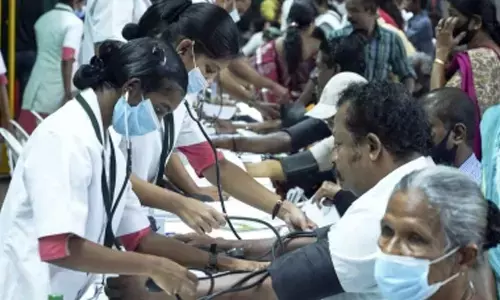Know your status

This December 1, 2018 marks the 30th anniversary of World AIDS Day This years theme is Know Your Status The purpose is to encourage every adolescent and adult to get testedfor HIV and should they test positive, to initiate early treatment and improve the chances of survival Such knowledge also helps people make informed choices about HIV prevention and empowers them to protect themselves and
This December 1, 2018 marks the 30th anniversary of World AIDS Day. This year’s theme is “Know Your Status.” The purpose is to encourage every adolescent and adult to get testedfor HIV and should they test positive, to initiate early treatment and improve the chances of survival. Such knowledge also helps people make informed choices about HIV prevention and empowers them to protect themselves and their loved ones from this dreaded infectious disease.
Even as much progresson this front has been madeover the last 30 years, people in India are still hesitant about getting screened for HIV. According to NACO, an estimated 2.1 million Indians are living with HIV ,but many moreinfected individuals remainundiagnosed.Social stigma is the main barrier to HIV testing and most people only get tested after reaching an advanced and difficult-to-treat stage of the disease.
I would like to recommend that all individuals between the ages of 13 and 64 should get screened for HIV at least once in their life time even if they have a risk-free lifestyle. If properly implemented, universal HIV testing will go a long way in tracking infected individuals and help us provide treatment and care to patients in the initial stages of their disease. A secondary benefit of universal testing would be reduced transmission of the virus from high-risk groups to the general population by catching and treating them early.In India, however, universal HIV testing remains a controversial and highly debated issue.
India’s high-risk groups comprise people who inject drugs (PWID), men who have sex with men (MSM), female sex workers (FSW), the ‘bridge population’ (truckers and migrants) and transgenders (TGs).We need to expand existing HIV testing interventions to these population groups and find ways to link them to treatment and care. The government’s Targeted Intervention program is doing a good job in this respect, by enabling screening and treatment of sexually transmitted infections (STIs), free distribution of condoms and lubricants and sessions on behavioral change communication within local communities. The model shows great promise and I hope that it is soon scaled to reach every high-risk group in the country.
At present, we are far behind our 2012 goal of achieving “Zero new infections, Zero deaths, Zero discrimination and Zero transmission.”Much of thiscan be ascribed to an overall lack of robust screening strategies in the country. What wenow need is increased investment and public sector commitment to intensify HIV control efforts, as well as novel and innovative approaches to make HIV testing more accessible and scalable. This includes but is not limited to government support to test and treat, funding by government agencies and NGOs, debunkingexisting myths about the disease, and encouraging people to get themselves screened.
Since HIV treatment requires lifelong medication, we must also explore ways to provide sustained access to HIV treatment. People who qualify as ‘high-risk’ should be initiated on pre-exposure prophylaxis (PrEP) therapy at the earliest. Through a simple once-daily pill, PrEP considerably reduces the risk of HIV infection. According to current estimates, a mere 500 to 700 at-risk people in India are on PrEP. By scaling up access to PrEP and integrating it into existing community programs, we can hope to further improve overall success of our HIV control interventions.
According to UNAIDS, three in four people living with HIV are aware of their status . We still have miles to go to ensure 100% status awareness, which will rely a great deal on reaching suspected high-risk individuals and HIV+ people unaware of their status and ensuring that they are linked to quality treatment and post-treatment services.
- Dr M Satyanarayana
















